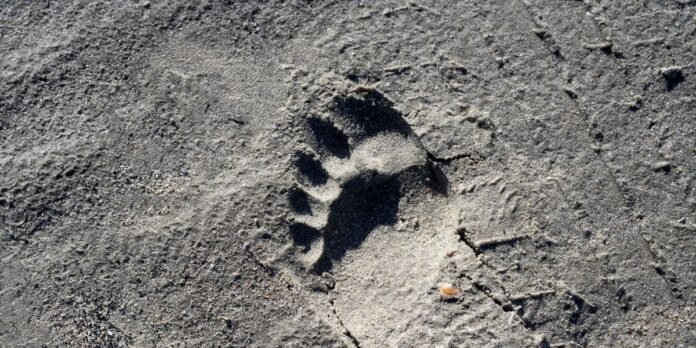Here’s what you’ll learn when you read this story:
- The oldest-known hominin track sites found in southwest Europe provide clues to the hunting patterns of Neanderthals.
- Experts believe that along with eating plenty of plants, the ancient population also hunted deer, horses, and rabbits.
- Neanderthals were eager to explore neighboring regions to discover mammals which they could add to their diet.
A Neanderthal family, hunting 78,000 years ago along the dunes of what is now modern-day Portugal, was likely stalking a meal of red deer. Today, thanks to the discovery of fossilized footprints—a range of tracks showing an adult male and two children—scientists were able to piece together the family’s movements and how they coincided with the wild game the ancient hominin were known to crave.
In a new study published in Scientific Reports, a team of researchers from the University of Lisbon and the Naturtejo UNESCO Global Geopark used optically stimulated luminescence to date prints found on the coastal cliffs of Monte Clerigo, along with a single print left 82,000 years ago, roughly four miles away at Praia do Telheiro.
The footprints along Portugal’s shifting coastal environment are considered “the first two hominin track sites found in the southwestern most region of Europe.”
In the report, the team chronicles five trackways at Monte Clerigo that contain 26 total prints. They were able to determine that three of the tracks were left by an adult male—likely between 5-foot-6 and 5-foot-8 in height—twice from ascending the cliff dune and once descending. The other two tracks were left by children, one likely between the ages of 7 and 9, and the other from a toddler, probably younger than 2 years old.
When the fossilized prints of a red deer were found on the same dune, the researchers came to believe the family was hunting the deer, using the undulating landscape to attempt to sneak up on the prey.
“Tracks of three individuals demonstrate how Neanderthals navigated dune landscapes,” the study authors wrote. It also gives more credence to the belief that coastal environments were used by Pleistocene humans and that they were important areas in “shaping hominin cognitive and social development.”
The footprints, a combined result of foot anatomy, gait dynamics, and substrate properties, help tell the story of the family, which was likely camping nearby the dunes.
“A review of the Neanderthal coastal sites associated with faunal evidence shows that their diet was primarily centered on cervids [deer], horses, and hares,” the study authors wrote. “The consistent presence of these mammal taxa highlights their role as reliable food sources, irrespective of the varying environments inhabited by Neanderthals. In addition, the Neanderthal diet also incorporated animals form neighboring littoral habitats, indicating a broad foraging strategy that capitalized on local biodiversity.”
At Monte Clerigo’s five trackways, the busiest featured 10 prints in one track.
The single footprint found at Praia do Telheiro, which was dated about 4,000 years older than those found at Monte Clerigo, was that of a “slim” foot, likely belonging to a female, the authors wrote.
There’s no additional evidence to tell if the female at Praia do Telheiro was on the hunt for red deer, horse, or rabbit.
Tim Newcomb is a journalist based in the Pacific Northwest. He covers stadiums, sneakers, gear, infrastructure, and more for a variety of publications, including Popular Mechanics. His favorite interviews have included sit-downs with Roger Federer in Switzerland, Kobe Bryant in Los Angeles, and Tinker Hatfield in Portland.






